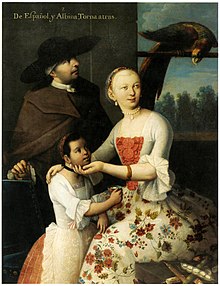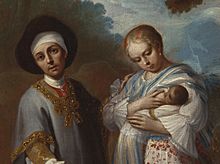
Torna atrás (Spanish pronunciation: [toɾnaˈtɾas]) or tornatrás is a term used in 18th century Casta paintings to portray a mestizo or mixed-race person who showed phenotypic characteristics of only one of the "original races", such as European or Amerindian ancestry. The term was also used to describe an individual whose parentage was half white and half "albino".



Spanish America
The term torna atrás (in English, similar in meaning to "throwback" or "harken back to") could also refer to the appearance of racial characteristics not visible in the parents. An example is the child of a white person and a light-skinned person of partial African ancestry (albino) born with darker skin than their African-descended parent.
The term torna atrás does not appear as a legal category in colonial documentation, but it is often shown in families portrayed in casta paintings in eighteenth-century Mexico.
| Miguel Cabrera, 1763 | Andrés de Islas, 1774 | Luis de Mena, ca. 1750 |
|
|
|
Philippines
The term tornatrás was also used in the Philippines during the Spanish colonial era from the 16th to 19th century, to describe persons of mixed Austronesian (referred to in Spanish as indio), Chinese (referred to in Spanish as Sangley), and Spanish ancestry (referred to in Spanish as español (or kastila in Filipino/Tagalog), specifically either filipinos/insulares (Spaniard born/raised in Spanish Philippines) or americanos (Criollo born/raised in Spanish America) or peninsulares (Spaniard born/raised in Iberia) ), or just mixed Chinese and Spanish ancestry.
Although tornatrás was originally used to describe a descendant of mestizos, albinos and Europeans, in the Philippines they were commonly known as those born from a Spanish father and a mestiza de Sangley (mixed native and Sangley Chinese) mother or a pure-blooded Sangley Chinese mother; they can be born to any mixed native and Spanish parent and any mixed native and Chinese parent. Most tornatrás who were mostly middle-class people in Spanish Philippines used Spanish as their primary language multilingually with Philippine languages and/or Hokkien Chinese, and in many cases converted to the Catholic faith. Examples of famous tornatrás persons in colonial history are José Rizal, Andrés Bonifacio, and Manuel Quezon.
See also
Notes
- Should not be confused with Albinism
References
- ^ "Definición de tornatrás". Real Academia Española. Retrieved 21 September 2016.
- Katzew (2004), Casta Painting, 101-106. Paintings 1 and 3-8 private collections; 2 and 9-16 Museo de América, Madrid; 15 Elisabeth Waldo-Dentzel, Multicultural Music and Art Center (Northridge California).
- Katzew, Ilona. Program for Inventing Race: Casta Painting and Eighteenth-Century Mexico, April 4-August 8, 2004. LACMA
- Cline, Sarah. “Guadalupe and the Castas: The Power of a Singular Mexican Colonial Painting”. Mexican Studies/Estudios Mexicanos Vol. 31, Issue 2, Summer 2015, pages 218–247.
- Christopher Knight, "A Most Rare Couch Find: LACMA acquires a recently unrolled masterpiece." Los Angeles Times, April 1, 2015, A1.
- Mallat, Jean (1846). Les Philippines; histoire, géographie, moeurs, agriculture, industrie et commerce des colonies espagnoles dans l'Océanie Vol. 2. Arthus Bertrand. p. 135.
- Macdonald, Roderick (2021). Open and Closed Economies Lessons from the Philippines and Vietnam. Springer International Publishing. p. 71. ISBN 9783030795344.
| Casta terms for interracial marriage in Spanish America | |||||||||||||||||||||||||||||||||||||||||||||||||||||||||||||||||
|---|---|---|---|---|---|---|---|---|---|---|---|---|---|---|---|---|---|---|---|---|---|---|---|---|---|---|---|---|---|---|---|---|---|---|---|---|---|---|---|---|---|---|---|---|---|---|---|---|---|---|---|---|---|---|---|---|---|---|---|---|---|---|---|---|---|
| |||||||||||||||||||||||||||||||||||||||||||||||||||||||||||||||||
| Miscegenation in the Spanish Philippines | |||||||||||||||||||||||||
|
|